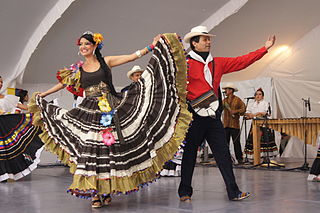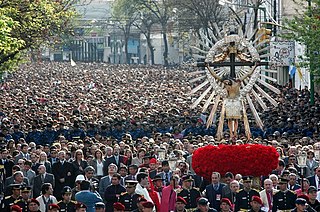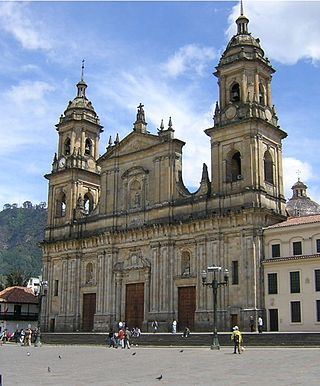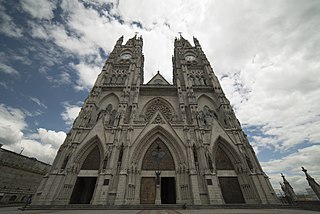Related Research Articles

Many aspects of Colombian culture can be traced back to the early culture of Spain of the 16th century and its collision with Colombia's native civilizations. The Spanish brought Catholicism, the feudal encomienda system, and a caste system that favored European descendants.

The predominant religion in Brazil is Christianity, with Catholicism being its largest denomination.

Christianity is the most widely professed religion in Argentina, with Roman Catholicism being its largest denomination. This historical background is very much due to the Spanish influence brought about through the newly conquered territories. However, affiliation with Protestant churches is increasing and immigration throughout the 20th century has brought other religions from various regions to Argentina.

The Catholic Church is "the Catholic Communion of Churches, both Roman and Eastern, or Oriental, that are in full communion with the Bishop of Rome ." The church is also known by members as the People of God, the Body of Christ, the "Temple of the Holy Spirit", among other names. According to Vatican II's Gaudium et spes, the "church has but one sole purpose–that the kingdom of God may come and the salvation of the human race may be accomplished."

The Colombian Catholic Church, or Catholic Church in Colombia, is the branch of the Catholic Church in the South American nation of Colombia.

Religion in the Netherlands was dominated by Christianity between the 10th and 20th centuries. In the late 19th century, roughly 60% of the population was Calvinist and 35% was Catholic. Also, during the Holocaust, there was a big Jewish population. Since then, there has been a significant decline in both Catholic and Protestant Christianity, with Protestantism declining to such a degree that Catholicism became the foremost form of the Christian religion. The majority of the Dutch population is secular. Relatively sizable Muslim and Hindu minorities also exist.

Colombians are people identified with the country of Colombia. This connection may be residential, legal, historical or cultural. For most Colombians, several of these connections exist and are collectively the source of their being Colombian.

The National Administrative Department of Statistics (DANE) does not collect religious statistics, and accurate reports are difficult to obtain. However, based on various studies and a survey, about 90% of the population adheres to Christianity, the majority of which (70.9%) are Roman Catholic, while a significant minority (16.7%) adhere to Protestantism and other Christian groups.
The National Administrative Department of Statistics (DANE) does not collect religious statistics, and accurate reports are difficult to obtain. However, based on various studies and a survey, about 90% of the population adheres to Christianity, the majority of which (70.9%) are Roman Catholic, while a significant minority (16.7%) adhere to Protestantism.

Religion in Colombia is dominated by various branches of Christianity and is an expression of the different influences in the Colombian culture including the Spanish, the Native Amerindian and the Afro-Colombian, among others.

Christianity is the predominant religion in El Salvador, with Catholicism and Protestantism being its main denominations. The Catholic share of the population is on decline while Protestants are experiencing rapid growth in recent decades.

In 2022, the constitution of Belgium provides for freedom of religion. The law prohibits discrimination based on religious orientation; however federal law bans face-coverings being worn in public.

When it comes to religion, the Ecuadorian society is relatively homogeneous, with Christianity being the primary religion. Catholicism is the main Christian denomination in the country. There are also small minorities of other religions.

Christianity is the largest religion in Cape Verde, with Roman Catholics having the most adherents. Different sources give varying estimates on the relative sizes of various Christian denominations. More than 94% of the population of Cape Verde is Christian, with almost 85% being Roman Catholic. About 5% of the population is Protestant. The largest Protestant denomination is the Church of the Nazarene. Other groups include the Church of the Nazarene, the Assemblies of God, Seventh-day Adventist Church, the Universal Church of the Kingdom of God, independent Baptists and various other Pentecostal and evangelical groups.

Christianity is the predominant religion in Costa Rica, with Catholicism being its largest denomination. Catholicism is also the state religion, but the government generally upholds people's religious freedom in practice.
Protestantism has had a small impact on Spanish life. In the first half of the 16th century, Reformist ideas failed to gain traction in Castile and Aragon. In the second half of the century, the Hispanic Monarchy and the Catholic Church managed to clear the territory from any remaining Protestant hotspot, most notably after the autos-da-fé in Valladolid (1559) and Seville (1560), from then on. 16th-century Inquisition blurred differences between erasmism, iluminismo and protestantism as if they belonged to a common branch.

The demographics of Colombia consist of statistics regarding Colombians' health, economic status, religious affiliations, ethnicity, population density, and other aspects of the population. Colombia is the second-most populous country in South America after Brazil, and the third-most populous in Latin America, after Brazil and Mexico.

Protestantism is the largest religious minority in Mexico.
William Mauricio Beltrán Cely – Colombian sociologist and Universidad Nacional de Colombia professor whose area of interests are secularization and religious pluralisation in Colombia, and the growth of Protestantism.
The status of religious freedom in South America varies from country to country. States can differ based on whether or not they guarantee equal treatment under law for followers of different religions, whether they establish a state religion, the extent to which religious organizations operating within the country are policed, and the extent to which religious law is used as a basis for the country's legal code.
References
- ↑ Cely, Beltrán; Mauricio, William (2013). Del monopolio católico a la explosión pentecostal' (PDF) (in Spanish). Universidad Nacional de Colombia, Facultad de Ciencias Humanas, Centro de Estudios Sociales (CES), Maestría en Sociología. p. 101. ISBN 978-958-761-465-7. Archived from the original (PDF) on 27 March 2016.
- ↑ Beltrán Cely, William Mauricio. Del monopolio católico a la explosión pentecostal' (PDF) (in Spanish). Universidad Nacional de Colombia, Facultad de Ciencias Humanas, Centro de Estudios Sociales (CES), Maestría en Sociología. ISBN 978-958-761-465-7. Archived from the original (PDF) on 2016-03-27. Retrieved 2016-05-18.
- ↑ Beltrán Cely, William Mauricio. "Descripción cuantitativa de la pluralización religiosa en Colombia" (PDF). Universitas humanística 73 (2012): 201–238. – bdigital.unal.edu.co. Archived from the original (PDF) on 2014-03-29. Retrieved 2016-05-18.
- ↑ "Religion in Latin America, Widespread Change in a Historically Catholic Region". pewforum.org. Pew Research Center. November 13, 2014.
- ↑ Colombian Constitution of 1991 (Title II - Concerning rights, guarantees, and duties - Chapter I - Concerning fundamental rights - Article 19)
- 1 2 US State Dept 2022 report
- ↑ Christian Solidarity Worldwide, report dated March 22, 2022
- ↑ Freedom House website, retrieved 2023-08-08
- ↑ Open Doors website, retrieved 2023-08-08